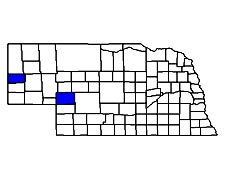
| Amblycheila cylindriformis Say |
| Adult Length: 24 to 36 mm |
| Appearance: This is the largest tiger beetle species in Nebraska. Adults are blackish to reddish brown in color with distinct striations on the elytra. It has been speculated that the appearance largely mimics that of certain noxious large tenebrionid beetles. |
| Similar Species: There is no other tiger beetle in Nebraska with which this species would likely be confused. It could, however, be confused with various carabid or tenebrionid beetles. No other beetle this large with a head as broad as the thorax and fitting the description of this species is likely to be found in Nebraska. |
| Biology: Adults can be found in short-grass and mixed-grass prairies. Because it is a flightless species adults should be expected in the greatest numbers near larval habitat, which is steep bare slopes consisting of fine particle soils such as clay and loess. Both the larvae and adults are nocturnal. Overall the species is very poorly known in Nebraska. |
| Adult Life History: Adults emerge from the pupa mostly in June and July and some may survive into October. Peak activity occurs from June to August. |
| Larval Life History: This species is unique among Nebraska's fauna in that larvae occur in clusters. Females of this genus generally lay eggs in groups, unlike those of Tetracha and Cicindela, which lay eggs singly. Larvae occur in burrows in steep bare clay and loess slopes, with the burrow opening perpendicular to the soil surface. Burrows may be from 100 to 160 cm in depth. The larval stage likely requires three to four years of development. |
| Biogeography: This species has only been recorded from two counties in western Nebraska. It likely occurs in other areas, but its nocturnal habits likely make it a species not likely to be encountered by the average naturalist. In North America it has been recorded from western South Dakota through eastern Colorado and central Kansas to western Texas. Members of this genus (of which there are five known species, all restricted to western North America) are poorly known, and are among the most primitive of all tiger beetles. The other primitive genera are also flightless and include Omus of the Pacific Northwest; Picnochile, which is represented by a single South American species; Platychile, which is represented by a single western African species; and Mantichora, which includes the ten largest tiger beetle species in the world. The genus is restricted to southern Africa, and adults are typically over 40 mm in length. |

